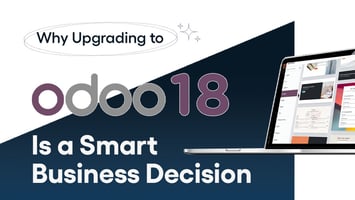
Common Challenges in Odoo Migration & How to Overcome Them
Deepti

ERP migration is more than a software upgrade—it’s a turning point for your business.
And if you’re here, chances are you’re either planning to switch to Odoo or upgrade to its latest version. That’s a smart move. As a modular, open-source ERP platform, Odoo is designed for growth, agility, and complete business automation.
But like any big move, migration comes with its own set of challenges. The good news? You can overcome each one—with the right approach and expert guidance.
In this blog, we’ll break down:
- Why businesses are migrating to Odoo
- The most common pitfalls you should watch out for
- Proven best practices to make your migration smooth and strategic
Why Businesses Are Migrating to Odoo
Companies across industries are making the shift to Odoo to get rid of fragmented systems and outdated processes. Whether it's replacing legacy ERPs or moving from spreadsheets, here are the top reasons organizations choose Odoo:

Common Challenges in Odoo Migration
Migrating to a new ERP isn’t plug-and-play—it’s a complex move that affects data, people, and processes. Here are the six most common challenges you might face along the way.
1. Data Migration Complexities
Transferring data from your old system into Odoo can be tricky. Every ERP has its own data structures, and mismatched formats or fields can lead to loss, duplication, or corruption of key information.
What can go wrong:
- Missing invoice histories or customer data
- Incorrect product or stock levels
- Manual cleanup after go-live
2. Custom Module Incompatibility
If your current Odoo system includes custom-built modules, you’ll need to validate their compatibility with the new version. Odoo upgrades often bring changes in the backend framework, which means your customizations may no longer work as expected.
What can go wrong:
- Broken functionality in core business areas
- Delays caused by re-coding or testing custom modules
3. Integration Breakage
Odoo works best when integrated with tools like Shopify, QuickBooks, HubSpot, and more. But after migration, these integrations may require reauthentication, new API configurations, or even updates on both ends.
What can go wrong:
- Orders not syncing between platforms
- Financial data out of sync
- Workflow disruptions across teams
4. Downtime and Workflow Disruption
If the migration isn’t carefully planned, it can interrupt key processes like order fulfillment, payroll, or inventory updates. Even a few hours of downtime during peak periods can hurt business performance.
What can go wrong:
- Delayed customer deliveries
- Payment processing errors
- Employee frustration and lost productivity
5. User Resistance to Change
New systems mean new ways of working. Teams may be hesitant or overwhelmed by a new interface or different workflows, especially if they weren’t involved in the process.
What can go wrong:
- Low adoption and poor ROI
- Increased support requests
- Errors due to improper system use
6. Inadequate Testing Before Go-Live
Skipping or rushing through testing is one of the costliest mistakes in ERP migration. What looks good on paper can fail under real user conditions.
What can go wrong:
- Role permissions misconfigured
- Workflows not aligned with real business processes
- Critical issues showing up after launch, under pressure
Best Practices to Overcome Migration Challenges
Now that we’ve seen what can go wrong, let’s walk through how to make it go right.
These best practices aren’t just technical—they’re strategic.
1. Conduct a Pre-Migration Audit
Start by understanding what’s in your current system. Audit your data, review your custom modules, document existing workflows, and outline integration points. This helps you identify risks early and plan your migration scope clearly.
2. Choose the Right Odoo Migration Partner
A certified Odoo Partner brings experience, tools, and methodology to guide your migration. From handling data transformation to upgrading modules and managing go-live—they take the stress off your internal teams.
Look for a partner who offers:
- Version-to-version upgrade support
- Module and data compatibility checks
- Integration planning and optimization
- Post-go-live assistance
3. Develop a Custom Migration Roadmap
No two migrations are the same. Your roadmap should reflect your business size, the number of apps in use, data volume, custom features, and your industry compliance needs. A well-defined roadmap reduces surprises and keeps your teams aligned.
4. Use a Sandbox for Testing
Before launching your new system, build a sandbox environment that mirrors your live system. This allows you to run test migrations, verify workflows, and simulate user interactions without impacting real operations.
Key areas to test:
- Reports and dashboards
- Data accuracy
- Role-based permissions
- API integrations
5. Train Your Teams Early
Change management is just as important as technical readiness. Provide training sessions, quick-start guides, and ongoing support tailored to each team’s role. The more confident your users are, the faster the adoption—and the smoother the go-live.
6. Plan for Post-Migration Support
Don’t disappear after go-live. You’ll need a few weeks of close monitoring to catch any issues and support users in real time. Your Odoo partner should offer both remote and on-site support as needed to ensure a clean transition.
Why a Trusted Migration Partner Matters
Here's a quick comparison of what happens with vs. without a specialized migration partner:

Partnering with an expert isn’t just a safety net—it’s your strategic edge.
Wrapping Up
Migrating to Odoo isn’t just about installing new software. It’s about building a smarter, faster, and more connected way of doing business.
Yes, there are challenges—but with the right preparation and support, you can turn those into stepping stones for growth.
Whether you're upgrading to the latest Odoo version or migrating from a different ERP, follow a process that includes auditing, planning, testing, training, and expert guidance—and your results will speak for themselves.
News Letter
Subscribe our newsletter to get our
latest update & news


